Museum pays long-due tribute to the artist
By Sally Vallongo, BLADE ARTS WRITER
The BLADE, Friday, July 15, 1994

In the 76-year history of the Toledo Area Artists Exhibition, few regional artists have equaled the record of Adam Grant, who was selected 33 times for the prestigious show, winning many of its top awards.
His large figure paintings in oil and his smaller pastel studies were collected and displayed by prestigious galleries and museums - Youngstown's Butler Institute of American Art gave him a solo exhibit - and by avid fans. When he died in June, 1992, at the age of 67, Grant was at work on a painting - perhaps another prizewinner.
Now, concurrent with the opening of its 76th Toledo Area Artists Exhibition, the Toledo Museum of Art has presented a solo show of Grant's work. It is a welcome, if belated, tribute to an artist who contributed significantly to the quality of art in this region.
Selected by Grant's widow, Peggy, and installed by curatorial associate Steve Frushour, the 14 oil paintings and pastels in the space outside the Little Theater warm and enliven the space with color and the scuIptural presence of human forms Grant explored in his painterly way over three decades at the easel.
Among the works here, many loaned from private collections, are winners of several TAAE awards. Dates on the labels would have facilitated tracking the artist's development, but aside from years painted into a few signatures, this information is missing.
Of particular interest are the pairings of pastel sketches used for planning with large oils. In Model in Green Skirt, Grant juxtaposed the lush texture of draped fabric around the model with a spare background in both works.
Here, the pastel stands out for the tension of the body, the stronger and more personalized face, and the abundance of surface activity. By contrast, the large oil is more generic, more tranquil, and far more abstract. It is a stunning transformation. In both works, Grant used the sharp angle of the model's bent elbow to break a strong vertical in the background, a powerful compositional device.
Between the pastel for Dancer in Pink and the oil, viewers can share the process by which the artist refined and further defined key places along the standing female form. In the pastel, quick patches of black and white jump out, showing how Grant would go back into a work to refine it. But in the large oil painted it from it, the incorporation of those additions is seamless and smooth.
Grant wasn't above showing the process of painting within the finished work. Several images suggest preliminary stages: The Yellow Easel pastel (a Roulet Medal winner) includes a black-white sketch of the nude mode} tacked on the wall behind the same image realized in color.
And in the 1978 painting The Red Rug, the artist shows the viewer how he connected his model to other natural elements. The background includes a working sketch of the nude and another drawing of a barren tree, its limbs echoing human ones. Grant further enhanced the curving line of leg and arm with a potted green plant on the floor.
The artist's palette of warm rose and gold, soft blue and green, and rich terra cottas and grays vibrate in the air around the paintings. In fact, the space itself seems to come alive with Grant's work. To visit the gallery is to engage his lively and questing mind, to see the world through his exacting eyes.
"Adam Grant Remembered" is to remain in place through July 31. Visiting hours are 10 a.m.-1 p.m. Tuesday-Saturday and 1-5 p.m. Sunday.